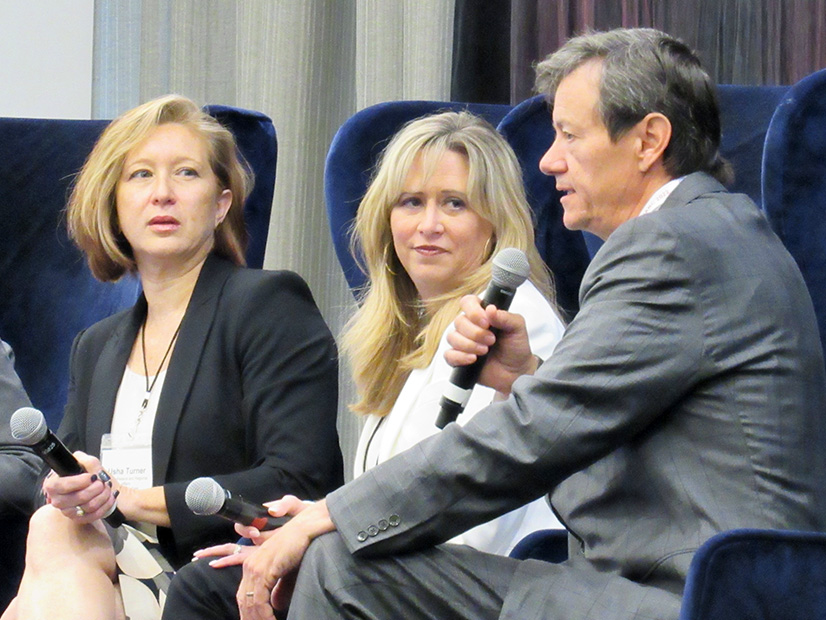
CHICAGO — The first annual meeting of the Mid-America Regulatory Conference (MARC) in two years focused on transmission needs in the middle of the country necessary for a fast-changing energy landscape.
Advanced Power Alliance’s senior vice president of markets and infrastructure Steve Gaw said both seams planning and interconnection queues deserve more attention in MISO and SPP. He said SPP’s planning futures are not realistic enough, as evidenced by its clogged interconnection queue.
“Transmission takes a long time to build. We’ve got a lot of work to do on that front. I think we have a good foundation, and I think we need to build on what’s working,” Gaw said during a Wednesday panel discussion.
ITC Holdings Chief Business Officer Krista Tanner said the two RTOs have come a long way on their seams planning.
“Two, three years ago, there was no communication on that. And now look,” she said, offering the caveat that MISO and SPP must still settle on a cost allocation for their joint targeted interconnection queue (JTIQ) planning study. (See MISO, SPP Finalize JTIQ Results with MISO Tx Duplicates.)
Tanner said the grid operators must do more planning to clear their queues. She said SPP’s five-year backlog is evidence that it’s not functioning well. However, she called the JTIQ work “a heck of a good start.”
“I’m not sure it can happen fast enough,” said Usha-Maria Turner, director of environmental, federal and RTO policy at Oklahoma Gas and Electric. “We’ll make progress on the current queue backlog, but … we’re seeing more and more renewables come into the queue, and that queue just has to get faster.”
Gaw called for a minimum transfer capability between RTOs and ISOs to maintain resource adequacy. He said the transmission that helped MISO and SPP successfully navigate the February 2021 winter storm wasn’t originally built to help the region’s punishing winter storms.
“A lot of the reason for those lines was to move renewable energy from the west to east, but because we had those lines, we were able to keep the lights on,” he said.
Tanner said the 16 lines in MISO’s 2011 Multi-Value Project portfolio were at capacity “the moment they came online.” She said MISO and its members have since miscalculated baseload retirements, load growth and the pace of renewable energy growth in their transmission planning.
“Everything was underestimated,” she said.
Tanner said though MISO’s $10 billion long-range transmission plan seems expensive, February 2021’s winter storm racked up a few hundred billion in costs in just over a week.
Tanner also zinged FERC’s Order 1000 as dysfunctional. She said ITC hasn’t bid on project under the order in years. She characterized the rulemaking as “a race to the bottom.”
“I think the good news is more people are recognizing that … it’s not saving customers money, it’s adding a lot of delay and then there’s litigation,” Tanner said.
Christie Urges States to Lean in on NOPR
FERC Commissioner Mark Christie, during his June 20 keynote address, encouraged state commissions to weigh in on the commission’s notice of proposed rulemaking on transmission planning and cost allocation. He reminded state staff that the “P” in NOPR stands for “proposed” and said the ruling isn’t final yet.
“It mandates the planning on a long-term horizon, but it doesn’t mandate the outcomes,” he said of the NOPR.
Christie said state regulators are poised to know what’s best for their customers.
“If we’re going to mandate billions worth of policy-driven transmission projects in the RTOs largely driven by state policies … [state regulators’] agreement ought to be sought on both the planning criteria and the cost allocation,” he said.
Christie said the NOPR stands to “formalize” states’ role in transmission planning and gives them “maximum creative and flexibility.”
“There’s no one I trust more than state regulators on making sure that projects are in the public interest and transmission expenditures are properly spent,” he said.
Christie also said state regulators, already squeezed for resources by the energy transition, must pay attention to planning. He said transmission investments are poised to explode.
“That transmission component in retail rates is getting bigger and bigger and bigger,” he said. “That component is not small anymore. It’s one of the fastest-growing components of people’s bills. It’s a challenge [to be involved], but you’re either going to be a part of it, or something that’s going to be done to you and your consumers.”


